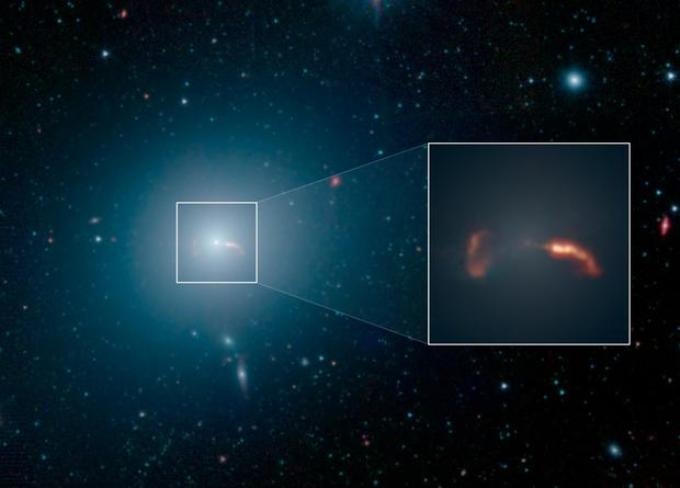Sep 25 2019
Black holes have never been weighed before because scales are not available for this. However, astrophysicists from the Moscow Institute of Physics and Technology (MIPT) have developed an innovative method to indirectly measure the mass of a black hole and also confirm its existence.
 Virgo A galaxy, also known as M87, and its jet. (Image credit: NASA/JPL-Caltech/IPAC)
Virgo A galaxy, also known as M87, and its jet. (Image credit: NASA/JPL-Caltech/IPAC)
The team tested this novel technique on the Messier 87 active galaxy. The method has been described in the Monthly Notices of the Royal Astronomical Society.
One of the brightest and most mysterious objects in space are said to be active galactic nuclei. If a galaxy generates a thin, long beam of energy and matter that is directed outward, it is considered as an active galaxy. This phenomenon is called a relativistic jet and is not caused by the stars existing in the galaxy.
The present agreement is that some kinds of “motors,” called galactic nuclei, produce the jets. While the nature of these galactic nuclei is not properly known, scientists believe that an active galaxy could be powered by a spinning black hole.
Within the Virgo constellation, Messier 87 is considered as an active galaxy that is closest to the planet Earth. This galaxy has also been extensively studied. Since 1781, it has been sighted regularly when it was originally identified as a nebula. Initially, astronomers did not realize that it was a galaxy and later came to know this. The galaxy’s optical jet—identified in 1918—was the first one to be ever visualized.
Meticulous examination was performed on the structure of the Messier 87 jet, mapping its plasma jet velocities as well as the temperature and particle number density close to the measured jet.
The boundary of the jet was comprehensively analyzed, which allowed scientists to figure out that it was not homogeneous along its length, altering from a parabolic to conical shape. Initially identified as an individual case, this impact was later established for 12 other galaxies, although Messier 87 continues to be the most distinct case of the phenomenon.
The level of observations makes it possible to test the theory with regard to the structure of active galaxies, such as the link between the gravitational effect of the black hole and the break in the jet shape. Both the existence of the giant black hole and jet behavior represent two sides of the same coin—the latter can be described in terms of the former, while hypothetical models of black holes are examined through jet observations.
The jet boundary includes segments of two distinct curves. This fact was leveraged by astrophysicists who utilized the distance between the break and core of the jet, as well as the width of the jet, to indirectly determine the spin and mass of the black hole.
For this purpose, the MIPT team created a technique that integrates telescope observations, computer calculations, and a theoretical model.
The scientists are attempting to explain the jet as a flow of magnetized fluid. In such a situation, the jet’s shape is established by its internal electromagnetic field, which consequently relies on numerous factors. The factors may include electric current inside the jet, the charge and speed of jet particles, and the speed at which the black hole accretes matter. An intricate interaction between these properties and physical phenomena results in the observed break.
A theoretical model is available that estimates the break. This would allow the researchers to establish which kind of black hole mass results in the model simulating the jet’s observed shape.
This resulted in a new model to estimate the mass of the black hole, a novel measurement technique, and to confirm the theories fundamental to the conceptual model.
The new independent method for estimation of black hole mass and spin is the key result of our work. Even though its accuracy is comparable to that of the existing methods, it has an advantage in that it brings us closer to the end goal. Namely, refining the parameters of the core ‘motor’ to deeper understand its nature.
Elena Nokhrina, Study Lead Author, Moscow Institute of Physics and Technology
Nokhrina is also the deputy head of the MIPT laboratory that was involved in the study.
The Laboratory of Fundamental and Applied Research of Relativistic Objects of the Universe explores binary black holes, quasar jets, and other tight binary systems. It also studies the magnetosphere structure of accretion disks, pulsars, and jets from new stars.
Apart from providing an understanding about the processes that occur in the Milky Way galaxy and the universe at large, the study has a practical dimension: It enhances the accuracy of the navigation systems that utilize remotely located quasars as reference points. Yuri Kovalev is the head of the laboratory and a corresponding member of the Russian Academy of Sciences (RAS).
Researchers from the MIPT were joined in this study by their collaborators from Lebedev Physical Institute, RAS; the Institute of Astronomy and Astrophysics, Taiwan; the Delft University of Technology and the Joint Institute for VLBI ERIC, the Netherlands; the Graduate University for Advanced Studies, Japan; and the National Astronomical Observatory of Japan.